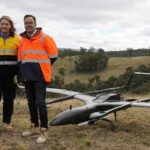If each hull had vertical topsides (slab sided), the outer gunwales would move inboard as the the hulls are canted.
Since maximum beam is measured as the widest point overall, the gunwales would end up inboard of the turn of the bilge (or more precisely the point where the tangent to the surface is vertical, so somewhere on the radius where the bottom of the hull turns up to meet the topsides).
On Paradox the outboard edge of the deck is at maximum beam with the hulls canted.
This means you are trapezing as far outboard as possible, giving you more leverage and maximising righting moment.
A byproduct of the wider deck is that overall hull stiffness is greater.
Since there is a bit more deck area, deck weight would be slightly greater for a given laminate spec. However the inherent stiffness of the flared shape means that less reinforcement is needed so there is no net weight gain.
In addition, since the inner gunwales are closer together, the trampoline is marginally narrower and hence a bit lighter, offsetting any weight gains in the deck.
Moving aft, topside flare is maintained to dampen pitching: as the stern submerges, the waterplane gets progressively wider, rapidly increasing waterplane area, and offering more support to restore a level attitude.
Keep the questions coming and we will attempt to post on the more frequent ones whenever time permits.









